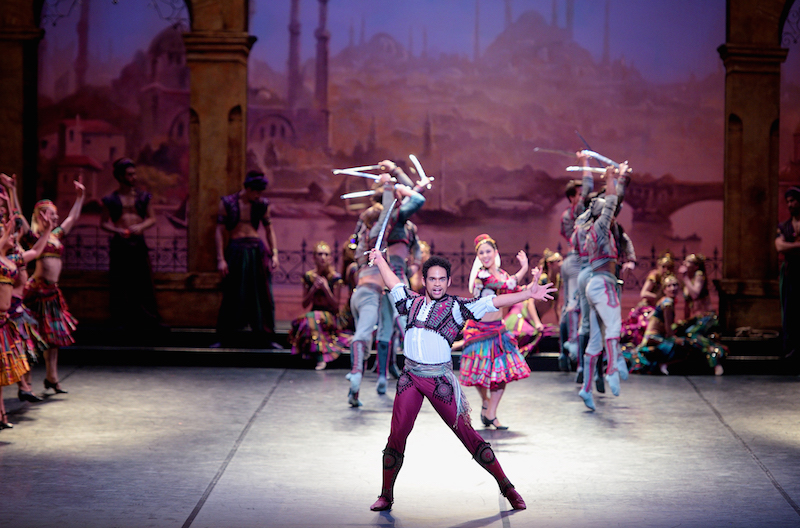It’s being sold as the ideal ballet for first-timers, but I would blush to introduce even my neighbour’s cat to this Carry On Up the Harem hokum. Worse, its silliness verges on offensive. When, in Rudolph Nureyev’s 1990s production of La Bayadère for Paris Opera Ballet, a chorus of blacked-up picaninnies appeared for about three minutes, you blinked and put it down to an unwise attempt at historical accuracy. By contrast ENB’s Le Corsaire, now embarking on its third London season, is almost entirely devoted to the simperings of sex slaves in spangly bras, the violent squabbles of a bunch of posturing pirates and the wet dreams of a pantomime harem-owner, and doesn’t for one moment have the feel of a product of the 1850s.
And yet it’s easy to see why the company’s dancers have taken this old warhorse to their hearts, and why Tamara Rojo – surely no slouch in the gender-politics department – thought fit to make Le Corsaire her first full-length commission. Unlike almost every other 19th-century ballet you can think of, it has great parts for men – OK, not great in terms of character development, but physically explosive. And if la Rojo’s artistic directorship, four years in, had to be characterised by one thing only, it would be her knack for finding and cultivating male talent. ENB is bursting with it, to the extent that the biggest cheers on opening night are for Junior Soloist Cesar Corrales, dancing the slave Ali with spectacular panache.
Forget anything you might know about Byron’s narrative poem of the same title. Act One of Corsaire has so little plot and ends on a note of such throwaway bathos that you wonder if something went wrong. Slave girls are salaciously roped together to be displayed for sale at a market, only for said slave girls, 30 seconds before the first curtain, to run away en masse. In refurbishing this production from the one she put together for American Ballet Theatre, that in turn built on a Soviet model, Anna-Marie Holmes might have taken the opportunity to fix this.
 So, the dancing’s the thing, and the dancing only, which makes it even more of a pity that Alina Cojocaru, scheduled to dance Medora but laid off by injury, has been replaced by Rojo for all her performances. Marvellous as it is that she manages to maintain her own dancing at the same time as running a company, Rojo would not be my ballerina of choice in this repertory. Cuban guest star Osiel Gouneo is her Conrad, a masterclass in how to command a stage and make sense of a silly part purely by believing in it. He has an appealing habit of appearing to take a long and lingering sniff at some mysterious perfume before launching into each of his solos, which only adds to the pantherish sensuality of his movement.
So, the dancing’s the thing, and the dancing only, which makes it even more of a pity that Alina Cojocaru, scheduled to dance Medora but laid off by injury, has been replaced by Rojo for all her performances. Marvellous as it is that she manages to maintain her own dancing at the same time as running a company, Rojo would not be my ballerina of choice in this repertory. Cuban guest star Osiel Gouneo is her Conrad, a masterclass in how to command a stage and make sense of a silly part purely by believing in it. He has an appealing habit of appearing to take a long and lingering sniff at some mysterious perfume before launching into each of his solos, which only adds to the pantherish sensuality of his movement.
The American Brooklyn Mack is the other high-flying guest, a demonic technician and beautiful to boot as the slave merchant Lankadem. ENB’s own Yonah Acosta makes a power-packed Birbanto, treacherous friend to Conrad, while Cesar Corrales, yet another Cuban, strips the paint from the floor with his scorchingly fast jetés as slave Ali, a character cursed to spend the rest of his stage time scurrying several paces behind everyone else. The second ballerina role of Gulnare belongs to Laurretta Summerscales, the fleetness of whose feet belie the lovely length of her limbs.
Tantalisingly, once or twice, you catch a strain of 'Giselle'’s sound world
Much has been made of the sets and costumes of Hollywood designer Bob Ringwood, and they are indeed good at summoning the generic “East” (Persia? Morocco? India?) of the 19th-century imagination, with nods to various European landscape painters of the time. As for staged shipwrecks, though, I’ve still seen nothing to beat the lurching realism of Lila de Nobili’s lo-tech 1958 designs for Frederick Ashton’s Ondine. And don’t expect Le Corsaire to send you out into the night humming the tunes, either. Not one of its 10 composers (yes, 10), managed to come up with anything memorable, though you do tantalisingly, once or twice, catch a strain of Giselle’s sound world in the contribution of Adolph Adam.
In the same way, you clutch at the coat-tails of Imperial choreographer Marius Petipa, whose stamp is still visible in a couple of the set pieces. One of these is the traditional vision scene, the so-called Jardin animé, danced very nicely by ENB’s corps with added children clad in pastel turbans. To get the effect originally intended, though, you’d need a corps of treble that size. And since this production does insist on trying to show us that this vision is the result of a bong-smoking session, Michael Coleman, hamming it up shamelessly as the randy old Pasha, will have to make it more obvious. The lighting could play its part too. With top ticket prices at the Coli now approaching Covent Garden levels (officially £102 for this, though discounts abound), there’s no excuse.
See this show for the circus fireworks, but don’t expect to be moved or enlightened.
Le Corsaire is at the Coliseum until January 24














Add comment